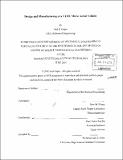Design and manufacturing of a VTOL Micro Aerial Vehicle
Author(s)
Gupta, Neil R. (Neil Rohin), 1975-
DownloadFull printable version (14.34Mb)
Alternative title
Design and manufacturing of a vertical take-off and landing MAV
Other Contributors
Massachusetts Institute of Technology. Dept. of Mechanical Engineering.
Advisor
John M. Plump.
Terms of use
Metadata
Show full item recordAbstract
The miniaturization of electronic guidance and navigation systems has opened a new frontier in aviation. The opportunity now exists to develop miniature aerial vehicles capable of autonomous flight. Such vehicles could perform reconnaissance missions in environments that are unsafe to humans. Their small size minimizes their chance of being detected in hostile areas and allows them mobility not afforded by typical full size vehicles and humans. The purpose of this thesis was to develop a 10" VTOL Micro Aerial Vehicle capable of high-speed forward flight. The innovative design incorporates a pair of counter-rotating, variable pitch propellers enclosed in a protective duct structure. Independent control of propeller pitch provides thrust and yaw control for the vehicle while in a hover mode. Translational control is provided by four independently actuated control surfaces which are placed in the area of high-speed flow aft of the propeller disks. In its forward flight mode, the duct acts as the primary lifting surface and the control surfaces act as movable canard wings. Power is provided by an off the shelf 0.25 cubic inch displacement 2-stroke glow-fuel engine. A volume of 9 cubic inches has been set aside in the main fuselage to house the Draper Micro Electromechanical integrated navigation package. A payload sensor bay with a volume of 3 cubic inches has also been incorporated into the design. Initial tests of this vehicle configuration indicate that it is a mechanically feasible design, which produces close to 75% of the thrust required to hover. Further development will focus on design refinements to create a lighter, more robust mechanical drive train, and aerodynamic analysis that will guide the redesign of the propeller.
Description
Thesis (S.M.)--Massachusetts Institute of Technology, Dept. of Mechanical Engineering, 2001. Includes bibliographical references (p. 115-116).
Date issued
2001Department
Massachusetts Institute of Technology. Department of Mechanical EngineeringPublisher
Massachusetts Institute of Technology
Keywords
Mechanical Engineering.